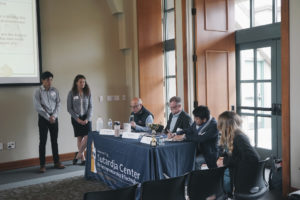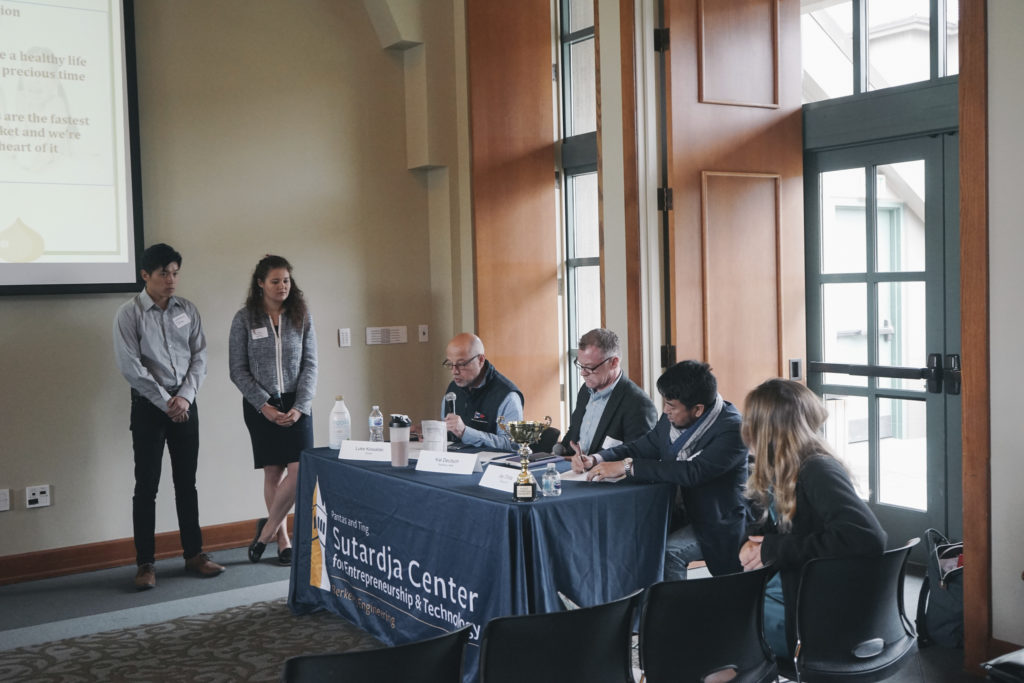After Hurricane Maria, aid organizations have made a point of distributing rations in Puerto Rico called MREs, which stands for Meals, Ready-to-Eat, to aid widespread food insecurity in the area. The problem is, among people who have actually had these meals, they’re more often called “Meals, Rarely Edible” or “Meals, Rarely Eaten.”
These rations simply don’t taste good and rarely give disaster survivors the proper nutrition they need. That’s why, four students taking the Sutardja Center for Entrepreneurship and Technology’s class on disaster recovery in Puerto Rico spent their semester working to create a tastier and healthier meal replacement.
The result was MIX: a meal powder that contains all of the nutrients that you need to live and that team members say tastes like “a healthy chocolate milkshake.”
The students ––Leonard Qian, Marie Maier, Varun Murthy and Michael Abdou –– were in part inspired by Soylent, but their product has an oat powder base so it is accessible for people who have soy or gluten allergies. It also is cheaper in cost than many other types of meal replacements, with each packet having a projected cost of about $1.89 and is specifically designed to help people who are malnourished gain weight.
“It’s often the simplest ideas that have the most weight” said Murthy, who is a first year. “Our project was just a powder. It wasn’t an AI project. But we could explain very clearly where our product sits in the disaster area.”
Their project was particularly well suited for SCET’s Challenge Lab on Disaster & Recovery in Puerto Rico, taught by instructor Rachel Powers. 85 percent of Puerto Ricans were food insecure in the wake of Hurricane Maria.
This strong need for their product was part of what helped them to win third place at Collider Cup, where the top students taking SCET classes pitch startup ideas they developed over the course of the semester and compete against one another.
“The most surprising thing, honestly, for me was being able to build something that people that people can actually use; that has a big customer base,” Murthy said.
During the course of the semester, the team members all went at least one day where they consumed only MIX. Qian, who developed the formula for the powder, lived off of it for three days straight.
Moving on, the team members are planning to meet and discuss how they can continue with this project now that their class has come to an end. In their Collider Cup presentation, they said that they would be interested in partnering with NGOs or other organizations that might be able to distribute their product in disaster areas.
The Sutardja Center for Entrepreneurship & Technology’s Challenge Lab Course on disaster and recovery in Puerto Rico encourages students to find innovative ways to solve the problems facing Puerto Rico in the wake of Hurricane Maria.
After Hurricane Maria, aid organizations have made a point of distributing rations in Puerto Rico called MREs, which stands for Meals, Ready-to-Eat, to aid widespread food insecurity in the area. The problem is, among people who have actually had these meals, they’re more often called “Meals, Rarely Edible” or “Meals, Rarely Eaten.”
These rations simply don’t taste good and rarely give disaster survivors the proper nutrition they need. That’s why, four students taking the Sutardja Center for Entrepreneurship and Technology’s class on disaster recovery in Puerto Rico spent their semester working to create a tastier and healthier meal replacement.
The result was MIX: a meal powder that contains all of the nutrients that you need to live and that team members say tastes like “a healthy chocolate milkshake.”
The students ––Leonard Qian, Marie Maier, Varun Murthy and Michael Abdou –– were in part inspired by Soylent, but their product has an oat powder base so it is accessible for people who have soy or gluten allergies. It also is cheaper in cost than many other types of meal replacements, with each packet having a projected cost of about $1.89 and is specifically designed to help people who are malnourished gain weight.
“It’s often the simplest ideas that have the most weight” said Murthy, who is a first year. “Our project was just a powder. It wasn’t an AI project. But we could explain very clearly where our product sits in the disaster area.”
Their project was particularly well suited for SCET’s Challenge Lab on Disaster & Recovery in Puerto Rico, taught by instructor Rachel Powers. 85 percent of Puerto Ricans were food insecure in the wake of Hurricane Maria.
This strong need for their product was part of what helped them to win third place at Collider Cup, where the top students taking SCET classes pitch startup ideas they developed over the course of the semester and compete against one another.
“The most surprising thing, honestly, for me was being able to build something that people that people can actually use; that has a big customer base,” Murthy said.
During the course of the semester, the team members all went at least one day where they consumed only MIX. Qian, who developed the formula for the powder, lived off of it for three days straight.
Moving on, the team members are planning to meet and discuss how they can continue with this project now that their class has come to an end. In their Collider Cup presentation, they said that they would be interested in partnering with NGOs or other organizations that might be able to distribute their product in disaster areas.
The Sutardja Center for Entrepreneurship & Technology’s Challenge Lab Course on disaster and recovery in Puerto Rico encourages students to find innovative ways to solve the problems facing Puerto Rico in the wake of Hurricane Maria.


